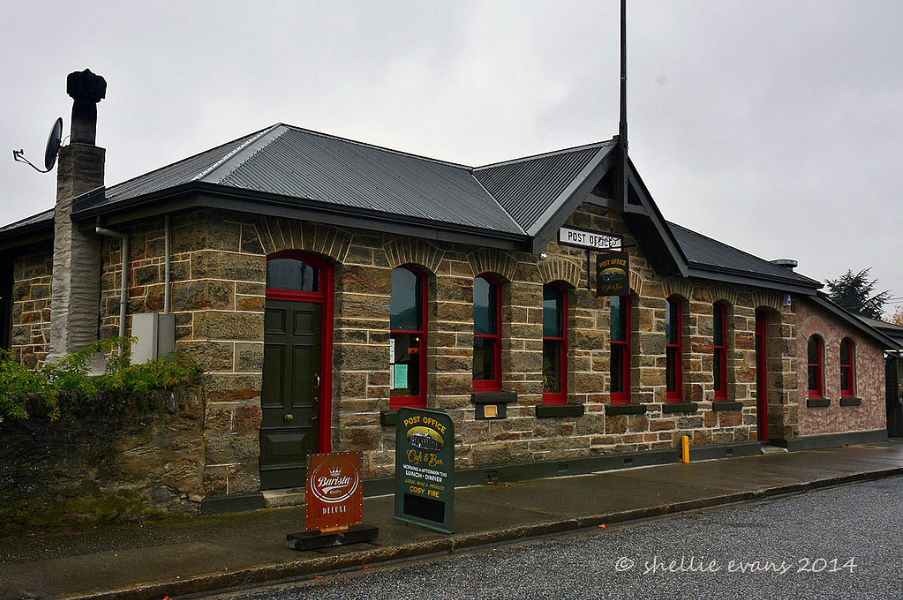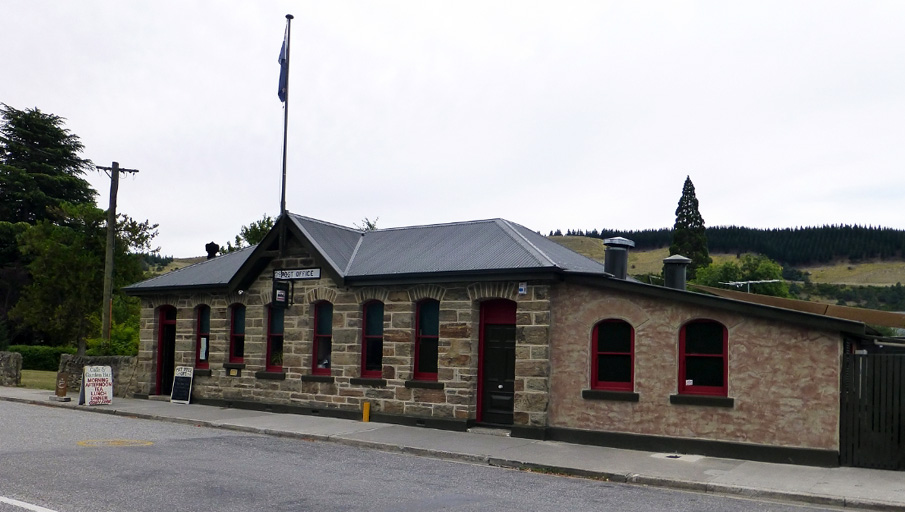The history of the town of Clyde is intrinsically linked with the history of the discovery and mining of gold in Central Otago. The first post office building dates to the beginning of the town in 1863. Although it was officially named Clyde in 1864, the town was first known as Dunstan in the 1850s and as Hartley's township after his discovery of gold in 1862. Gold mining began in Central Otago with Gabriel Read's discovery of gold in Gabriel's Gully, near present-day Lawrence, in 1861. The following year Hartley and Reilly left this gully and travelled further into Central Otago. They spent the winter prospecting in the now-flooded Clutha Gorge between present day Clyde and Cromwell, finding enough gold in the area to travel back to Dunedin and lodge 87 pounds with the Gold Receiver. The 1862 discovery precipitated a rush to the area, with the first passenger-carrying coach travelling from Dunedin to Clyde in November of that year. Six weeks earlier, the first gold escort had left Clyde for Dunedin with packhorses. Subsequent gold escorts consisted of a solid covered wagon with armed guards. A ragged canvas town quickly sprang up, and by December of that year between six and seven thousand miners and settlers occupied Clyde and the surrounding areas. Sunday afternoons would see up to 4000 men congregate in the town. At Christmas 1862, 320 people sat down to dinner at one of the "innumerable" hotels, the cost of the meal being 10s 6d. While Clyde was itself the centre of mining activity in 1862, as gold was quickly discovered in other parts of Central Otago such as Arrowtown and Queenstown it was also the source of supplies for those travelling on to other areas. A photograph dated c. 1862 shows a profile of canvas and wooden buildings along the terrace above the river where the town now stands, and a small collection of wooden structures on the lower beach. McCraw gives a date of 1865 for the same photograph, a more likely date given the number of structures and roads visible, and has annotated it with details of the infrastructure used to mine a seam of coal along the riverbank. By the late 1860s photographs show a row of single-storied wooden buildings running cheek-by-jowl along the main street, now known as Sunderland St . The buildings all feature flat-fronted facades with business signs, among them one named the Dunstan Hotel, and the Hartley Arms Hotel can be seen several doors along. These were just two of many hotels in the town. The first mails from Dunedin into Central Otago started in February 1857 at this time a hazardous and difficult journey when rivers were sometimes in flood and the terrain dangerous. These early mail runs were private undertakings by individuals on horseback, carrying mail to the first runholders in the district. In September 1862 the Otago Daily Times announced that one of these individuals, 'a well-known, and somewhat eccentric Dunedinite, rejoicing in the soubriquet of 'Red Coat', went through the town on Saturday morning last, mounted on horseback, announcing at the corners of streets to the inhabitants, called together by sound of trumpet, that he was about to proceed to the Hartley diggings...and that merchants, grass widows, forsaken sweethearts and others wishing to forward letters would find, upon payment of half a crown, that Red Coat would prove a fast and faithful courier. As Red Coat is well known to be a messenger whose probity may be relied on, there is no doubt but many will find such a medium of the utmost service, in the absence of any direct postal communication.' After the Dunstan gold rush the Postmaster-General reported that there had been such an increase in population in the province that postal arrangements had to be made. Staff were sent to urgently to Dunedin from the north. Startup gives a date of February 6, 1863 for the opening of the Dunstan post office, but there must have been a temporary office and official mail service prior to this. In January 1863 the Otago Witness reported that the Post Office at Clyde was unable to keep up with demands: 'A long file of people extending for nearly quarter of a mile, go up in turns to be served. It takes on an average about two hours to reach the window. From morning till night the office is besieged. An extra clerk would only be in the way, as the postmaster's den is a square cramped up building, filled already to suffocation.' Later in the same month the office was still under siege, the Daily Telegraph also complaining about the non-delivery of mail at Dunstan. The original post office structure resembled all the other early buildings in Clyde, constructed first from canvas and scantling (light timber framing) and later in wood and corrugated iron, located on the corner of Blyth St, several sections back from the current building. This was the earliest post office for the whole of the goldfields, and was the first to have an obliterator date-stamp. The first postmaster was R.A. Greenslade, succeeded by Alexander Hume, who earned a salary of £275. The earliest government mails were carried by packhorse. Veitch reports that the first Clyde mail contract was secured by Donald Malloch, who had spent the previous year carrying mail to runholders over the northerly Pig Root. By the 1870s Cobb and Co. obtained the contract. In winter when the snow was deep and impassable by coach the packhorse was sometimes used again. According to Robinson, the mail coach only travelled the full distance from Dunedin to Clyde once a week in the early 1870s. In 1865 the Electric Telegraph Act was passed, giving the government the power to construct and maintain telegraph communication. By the middle of this year there were nine telegraph stations, all in the South Island and in May 1866 Clyde was connected to this network. In 1900 the post office was built on its present site out of local schist, replacing the earlier wooden and corrugated iron structure on the corner of the street. An undated plan of the first part of the post office labelled Public Works New Zealand Post and Telegraph Office Contract Clyde Vincent County shows the left-hand (or north) door, with the first three of its final six windows. The budget for the building was £254-17s-0d, with an extra £6 allowed for contingencies. About ten years later the building was extended to house the telephone exchange after seven telephones were installed in 1909. The extension mirrored the design of the first part of the building, with a further three windows matching the original three and a door in the right (or south) end of the building. The builder and stonemason of both parts of the building, William Gair, was born in the Shetland Islands and came to New Zealand in 1878. He initially tried his luck at gold mining before turning to his stonemason's trade, living at Cromwell. Many of the stone buildings in Clyde and Cromwell, where he carried out work for the borough council, were built by him. The postmaster's residence on the neighbouring section to the post office is built of the same schist and in a similar style to the post office itself, presumably also constructed by Gair. In March 1989 following New Zealand Post's restructuring, the Vincent County Council purchased the post office and the adjacent postmaster's house and ran a postal agency for a number of years out of the post office building. Again after local body restructuring the post office and residence were transferred to the Central Otago District Council in 1991. The district council closed the postal agency in June 1993, the postal agency moving to a local garage, and gave notice of its intention to quit the building. Following community interest a syndicate of shareholders purchased the post office and opened the Post Office Café, Bar and Garden in December 1994. In 2002 the business was sold to its current owner, Aaron Muir Ltd. The adjacent former postmaster's residence is separately owned and operated as a bed and breakfast business.



Location
List Entry Information
Overview
Detailed List Entry
Status
Listed
List Entry Status
Historic Place Category 2
Access
Private/No Public Access
List Number
2384
Date Entered
6th June 2005
Date of Effect
6th June 2005
City/District Council
Central Otago District
Region
Otago Region
Extent of List Entry
Registration includes the land in Certificate of Title OT 13C/84 and the building, fixtures and fittings thereon. (See Plan in Appendix 4 of the registration report).
Legal description
Lot 1 DP 21806 (RT OT13C/848), Otago Land District
Stay up to date with Heritage this month
